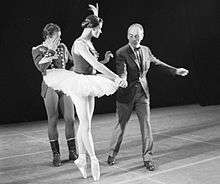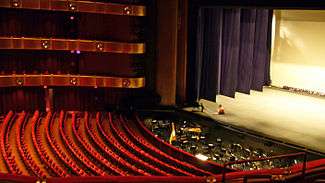New York City Ballet
| New York City Ballet | |
|---|---|
 | |
| General information | |
| Name | New York City Ballet |
| Previous names |
|
| Year founded | 1948 |
| Founders | |
| Founding choreographers | |
| Principal venue | |
| Website | www.nycballet.com |
| Artistic staff | |
| Ballet Master in Chief | Peter Martins |
| Ballet Mistress | Rosemary Dunleavy |
| Music Director | Andrew Litton |
| Other | |
| Orchestra | The New York City Ballet Orchestra |
| Official school | School of American Ballet |
| Associated schools | |
| Formation |
Principal Dancer Soloist Corps de Ballet |
New York City Ballet (NYCB) is a ballet company founded in 1948 by choreographer George Balanchine[1] and Lincoln Kirstein.[2] Léon Barzin was the company's first music director. Balanchine and Jerome Robbins are considered the founding choreographers of the company. City Ballet grew out of earlier troupes: the Producing Company of the School of American Ballet,[3] 1934; the American Ballet,[4] 1935, and Ballet Caravan, 1936, which merged into American Ballet Caravan,[5] 1941; and directly from the Ballet Society,[6][7] 1946.
History
In a 1946 letter, Kirstein stated, "The only justification I have is to enable Balanchine to do exactly what he wants to do in the way he wants to do it."[8] He served as the company's General Director from 1946 to 1989, developing and sustaining it by his organizational and fundraising abilities.[8]
The company was named New York City Ballet in 1948 when it became resident at City Center of Music and Drama.[9][10] Its success was marked by its move to the New York State Theater, now David H. Koch Theater, designed by Philip Johnson to Balanchine's specifications. City Ballet went on to become the first ballet company in the United States to have two permanent venue engagements: one at Lincoln Center's David H. Koch Theater on 63rd Street in Manhattan, and another at the Saratoga Performing Arts Center, in Saratoga Springs, New York. The School of American Ballet (S.A.B.), which Balanchine founded, is the training school of City Ballet.
After the company's move to the State Theater, Balanchine's creativity as a choreographer flourished. He created works that were the basis of the company's repertory until his death in 1983. His vision influenced dance both across the United States and in Europe. He worked closely with choreographer Jerome Robbins, who resumed his connection with the company in 1969 after having produced works for Broadway.

NYCB still has the largest repertoire by far of any American ballet company, and it often stages 60 ballets or more in its winter and spring seasons at Lincoln Center each year, and 20 or more in its summer season in Saratoga Springs. City Ballet has performed The Nutcracker, Romeo and Juliet, A Midsummer Night's Dream and many more. City Ballet has trained and developed many great dancers since its formation. Also, many dancers with already developed reputations have joined City Ballet as principal dancers.
|
|
|
Salute to Italy
In 1960 Balanchine mounted City Ballet's Salute to Italy with premieres of Monumentum pro Gesualdo and Variations from Don Sebastian (called the Donizetti Variations since 1961), as well as performances of his La Sonnambula and Lew Christensen's Con Amore. The performance was repeated in 1968.
Stravinsky Festival

In 1972 Balanchine offered an eight-day tribute to the composer, his great collaborator, who had died the year before. His programs included twenty-two new works of his own dances, plus works by choreographers Todd Bolender, John Clifford, Lorca Massine, Jerome Robbins, Richard Tanner and John Taras, as well as repertory ballets by Balanchine and Robbins. Balanchine created Symphony in Three Movements, Duo Concertant and Violin Concerto for the occasion. He and Robbins co-choreographed and performed in Pulcinella. Balanchine had produced an earlier Stravinsky festival in 1937 as balletmaster of the American Ballet while engaged by the Metropolitan Opera. The composer conducted the April 27th premiere of Card Party.
Ravel Festival
In 1975 Balanchine paid his respects to the French composer Maurice Ravel with a two-week Hommage à Ravel. Balanchine, Robbins, Jacques d'Amboise, and Taras made sixteen new ballets for the occasion. Repertory ballets were performed as well. High points included Balanchine's Le Tombeau de Couperin and Robbins' Mother Goose.
Tschaikovsky Festival
In 1981 Balanchine planned a two-week NYCB festival honoring the Russian composer Peter Ilyitch Tschaikovsky. Balanchine, Joseph Duell, d'Amboise, Peter Martins, Robbins and Taras created twelve new dances. In addition to presenting these and repertory ballets, Balanchine re-choreographed his Mozartziana from 1933. Philip Johnson and John Burgee's stage setting of translucent tubing was designed to be hung and lit in different architectural configurations throughout the entire festival.[11]
Stravinsky Centennial Celebration
In 1982 Balanchine organized a centennial celebration in honor of his long-time collaborator Igor Stravinsky, during which the City Ballet performed twenty-five ballets set to the composer’s music. Balanchine made three new ballets, Tango, Élégie and Persephone, and a new version of Variations.[12] The choreographer died the following year. Balanchine ’s 50th Anniversary Celebration was held by the company in 2002.
New York State Theater 20-Year Celebration
On April 26, 1984, NYCB celebrated the 20th anniversary of the New York State Theater. The program started with Igor Stravinsky's Fanfare for a New Theater, followed by Stravinsky's arrangement of The Star-Spangled Banner. The ballets included: three of Balanchine's works, Serenade, Stravinsky Violin Concerto, and Sonatine; and Jerome Robbins' Afternoon of a Faun. The performers included Maria Calegari, Kyra Nichols, Heather Watts, Leonid Kozlov, Afshin Mofid, Patricia McBride, Helgi Tomasson, Karin von Aroldingen, Lourdes Lopez, Bart Cook, and Joseph Duell.[13]
Peter Martins
After Balanchine's death in 1983, Peter Martins was selected as balletmaster of the company. After 30 years, Martins was judged to have maintained the New York City Ballet's financial security and the musicality and performance level of the dancers, but he has not emphasized the Balanchine style to the extent that many observers expected he would.[14]
American Music Festival
For the company's 40th anniversary, Martins held an American Music Festival, having commissioned dances from choreographers Laura Dean, Eliot Feld, William Forsythe, Lar Lubovitch and Paul Taylor. He also presented ballets by George Balanchine and Robbins. The programs included world premieres of more than twenty dances. Martins contributed Barber Violin Concerto, Black and White, The Chairman Dances, A Fool for You, Fred and George, Sophisticated Lady, Tanzspiel, Tea-Rose and The Waltz Project.[11]
Jerome Robbins celebration
A major component of the Spring 2008 season was a celebration of Jerome Robbins; major revivals were mounted of the following ballets:
Dancers' Choice
Friday, June 27, 2008 the first Dancers’ Choice benefit was held for the Dancers' Emergency Fund. The program was initiated by Peter Martins, conceived and supervised by principal dancer Jonathan Stafford, assisted by Kyle Froman, Craig Hall, Amanda Hankes, Adam Hendrickson, Ask la Cour, Henry Seth and Daniel Ulbricht, and consisted of:
and excerpts from:
Sunday June 14, 2009 the second Dancers’ Choice benefit was held at a special evening performance, the program included: Sleeping Beauty and Union Jack.[16][17] This program was supervised by principal dancer Jenifer Ringer.
Programming

NYCB performs fall, winter and spring repertory seasons at the David H. Koch Theater at Lincoln Center as well as George Balanchine's Nutcracker during November and December; they have a summer residency at the Saratoga Performing Arts Center and regularly tour internationally.
Fourth Ring Society and Talks
City Ballet's Fourth Ring Society offers discounted tickets to members. Membership is open to the general public.[18]
Introductory talks about the current performance, called Dancer Chats or First Position Discussions,[19] are held before some performances or during some intervals; the docents are volunteers and include laymen as well as former dancers.
New York Choreographic Institute
City Ballet's Choreographic Institute was founded by Irene Diamond and Peter Martins in 2000 . The institute has three main programmatic programs: choreographic sessions, providing choreographers with dancers and studio space; fellowship initiatives, annual awards in support of an emerging choreographer affiliated with a ballet company; and choreographic forums, symposia and round-table discussions on choreography, music, and design elements.
Present
The present artistic staff: [20]
Balletmaster in chief
Peter Martins, who first danced with City Ballet in 1967 joined the company as a principal dancer in 1970,[21] in 1981 was named balletmaster, a title shared with Balanchine, Robbins and John Taras. Martins served as co-balletmaster in chief with Robbins from 1983 to 1989 and assumed sole directorship of the company in 1990.
Balletmistress
Balletmasters
|
|
|
|
Guest teachers
Resident ChoreographerThe New York City Ballet OrchestraThe 66 member NYCB Orchestra is an important symphonic institution in its own right, having played for virtually all of the thousands of performances NYCB has given over the decades. It is one of the most versatile orchestras in the world, on any given week performing perhaps three or four times the repertoire that another symphony might be expected to do.[24] Principal players of the orchestra also perform the majority of the concertos, other solos, and chamber music the ballet performs to. The orchestra accompanies the ballet on all of its North American Tours, and while the ballet uses local orchestras on its international tours, often, members of the NYCB Orchestra will go along as soloists or extras. Besides the members of the orchestra, the NYCB has six other musicians (pianists) on full-time staff. All of them perform in the pit with the orchestra on a regular basis. The NYCB Orchestra also occasionally accompanies other dance companies when they visit The David H. Koch Theater from other cities. These engagements have included the Australian Ballet in the spring of 2012,[25] and the San Francisco Ballet[26] in the fall of 2013. Music DirectorAndrew Litton was appointed to the position on December 16, 2014 and will start in September 2015.[27] Staff ConductorsClotilde Otranto, Andrews Sill (acting Music Director 2012-2014 and thenceforward Associate Music Director.) Daniel Capps. Ryan McAdams (associate conductor 2011) Historical music directorsLeon Barzin 1948-c1963, Robert Irving ("The Duke") c1963-1989, Gordon Boelzner 1989-2000, Andrea Quinn 2000-2006 Fayçal Karoui 2006-2012. Other conductors of noteHugo Fiorato (retired 2004) (Conductor Emeritus), Maurice Kaplow (retired 2010) DancersReference:[28] Principal dancersMain article: List of New York City Ballet principal dancers
SoloistsMain article: List of New York City Ballet soloists
Corps de ballet
Former dancersFormer principal dancers
Former soloists
Former corps de ballet
Janice Levin Award dancers
References
Bibliography
External links
|